“Joseph and Emma: Moments in Their Lives,” Ensign, July 2012, 40–44
Joseph & Emma: Moments in Their Lives
Joseph Smith Jr. and Emma Hale met in October 1825 in Harmony, Pennsylvania, USA. Joseph and his father had traveled from their home in Palmyra, New York, USA, to work temporarily in Harmony for a farmer named Josiah Stowell. They and the other workers boarded on the Hale farm. After a month, Josiah abandoned his project, and Joseph’s father returned to Palmyra, but Joseph stayed to work on other local farms.
Emma was 21, an athletic young woman with a spirited attitude, a quick wit, and a lyrical soprano voice. At five feet nine inches, with a “dark complexion” and “piercing eyes,” she was “noble in appearance and bearing.”1
Joseph, 18 months her junior, was six feet tall, with light brown hair and blue eyes. Five years earlier, he had gone into a grove of trees on his family’s farm and prayed to know which church was true. God the Father and His Son, Jesus Christ, appeared to him—and the Restoration of the gospel began. From that time, controversy surrounded Joseph’s name. After Joseph and Emma fell in love, they eloped on January 18, 1827.
For the next 17 years until Joseph was martyred in Carthage, Illinois, USA, Joseph and Emma’s lives were never separated from the ongoing Restoration of the gospel of Jesus Christ. They led the Saints from Ohio to Missouri to Illinois. In 1832 when a mob tarred and feathered the Prophet, Emma spent the night removing the tar from his skin. Throughout their lives, they often gave up their bed and slept on the floor “with nothing but a cloak for bed and bedding.”2 Following are a few of the tender moments they shared.
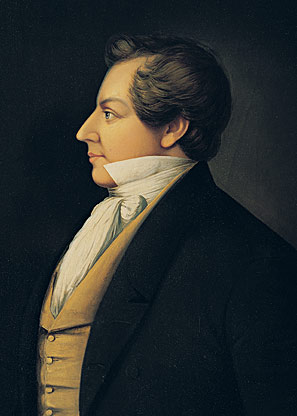
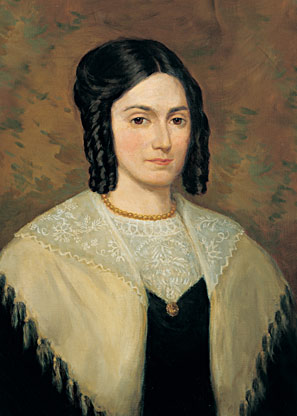
Above: Joseph Smith Jr. and his wife, Emma Hale Smith.
Joseph Smith, Jr., by Dan Weggeland, courtesy of Church History Museum; Emma Hale Smith, by Lee Greene Richards, © 1941 IRI
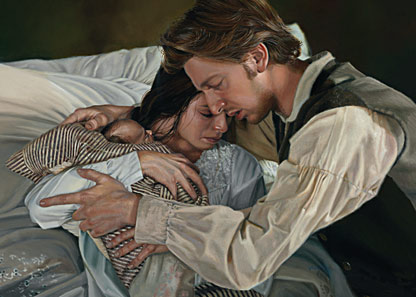
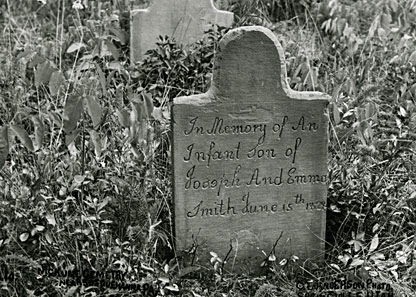
Above: But for a Small Moment, by Liz Lemon Swindle. Inset: Grave of Joseph and Emma’s firstborn child, Alvin, who died on June 15, 1828. The grave is located in the McCune Cemetery near Harmony, Pennsylvania. “Emma nearly lost her life following the difficult birth; her baby, born with un-described birth defects, survived only a short time.”3 Only five of Joseph and Emma’s 11 children (including two adopted) lived beyond childhood.
But For a Small Moment, © Liz Lemon Swindle; photograph of grave courtesy of Church History Library and Archives
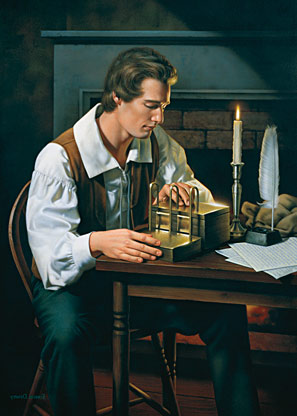

Left: By the Gift and the Power of God, by Simon Dewey. Above: A page of the original Book of Mormon manuscript translated by the Prophet Joseph Smith. Emma was among the few who served as the Prophet’s scribe before Oliver Cowdery, who served as scribe for the majority of the translation.
By the Gift and the Power of God, © Simon Dewey; photograph of Book of Mormon manuscript © 1988 IRI
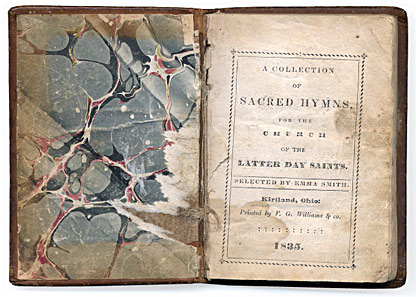
Right: A copy of the hymnbook compiled by Emma, printed in 1835 in Kirtland, Ohio, USA, and used during the Kirtland Temple dedication.
Left: 1835 hymnal courtesy of Church History Archives
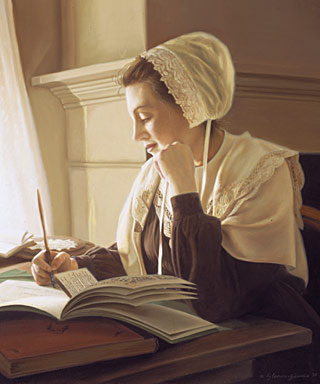
Right: In a July 1830 revelation given through the Prophet Joseph to Emma is a request “to make a selection of sacred hymns” (D&C 25:11). As with many hymnals of the time, this hymnal contained only the words of the hymns, not the music. Emma grouped the hymns by subject matter—Sacred Hymns, Morning Hymns, Evening Hymns, Farewell Hymns, Hymns of Baptism, the Sacrament, Marriage, and finally Miscellaneous Hymns.4
Emma’s Hymns, © Liz Lemon Swindle
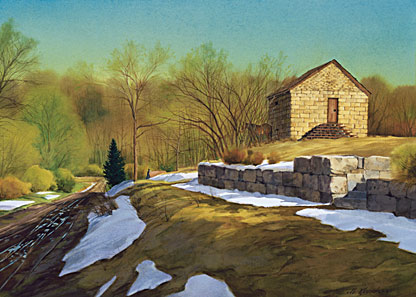
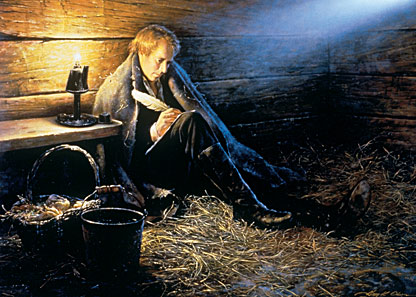
Above: Liberty Jail, 1839, by Al Rounds; Joseph Smith in Liberty Jail, by Greg K. Olsen.
Liberty Jail, 1839, © Al Rounds; Joseph Smith in Liberty Jail, © Greg K. Olsen—do not copy

Just as Joseph wrote letters while he was in the Liberty Jail (above), he wrote this letter (left) to Emma while imprisoned in Richmond, Missouri. An excerpt follows.
“Oh, my affectionate Emma, I want you to remember that I am a true and faithful friend, to you and the children, forever, [and] my heart is entwined around yours forever and ever. Oh, may God bless you all! amen. I am your husband and am in bonds and tribulation etc.
Joseph Smith Jr.
“P.S. Write as often as you can, and if possible come and see me; and bring the children if possible. Act according to your own feelings and best judgment, and endeavor to be comforted, if possible, and I trust that all will turn out for the best. Yours, J. S.” *
In response to this letter, Emma and the children visited Joseph (depicted left).
Letter from Joseph Smith to Emma Smith courtesy of Community of Christ Archives, World Headquarters, Independence, Missouri
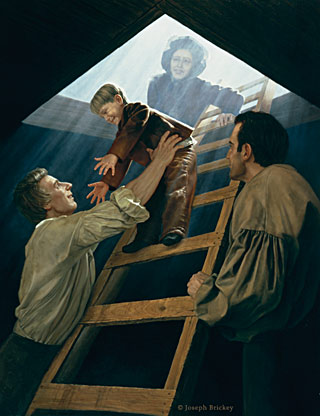
Right: Family Visit to Liberty Jail, by Joseph F. Brickey.
Family Visit to Liberty Jail, © Joseph Brickey
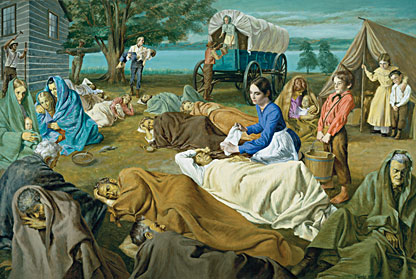
Right: Emma Smith, the Elect Lady, by Theodore Gorka. This painting depicts Emma and others working to relieve the suffering of the Saints during an outbreak of malaria.
Above: July 22, 1839, became known as “a day of God’s power.” The Prophet Joseph arose from his sickbed and led the mighty priesthood effort to bless the many Saints stricken with malaria in Commerce (later renamed Nauvoo), Illinois, USA, and also across the Mississippi River in Montrose, Iowa. Brigham Young, Wilford Woodruff, Orson Pratt, and John Taylor were among those healed in Montrose. As they left to return to Commerce, a man who lived some distance away asked the Prophet to come with him to heal his twin children. Joseph took a red silk handkerchief (below) from his pocket and gave it to Elder Woodruff. He told Wilford that if he wiped the faces of the children with the handkerchief, they would be healed—and they were.5
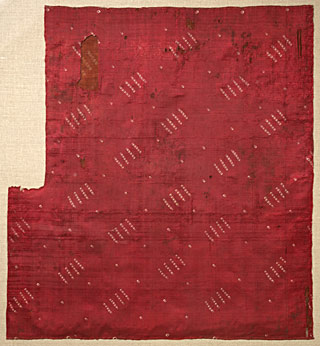
Emma Smith, the Elect Lady, by Theodore Gorka, © 1996 IRI; photograph of Joseph Smith’s handkerchief by Cody Bell, © IRI

Malaria-carrying mosquitoes thrived in the marshy land that was to be the site of Nauvoo, so the Saints drained the water by digging drainage ditches like the one above, which is still in use today.
Photograph of drainage ditch by Kenneth R. Mays; photograph of the pick by Cody Bell, courtesy Church History Museum